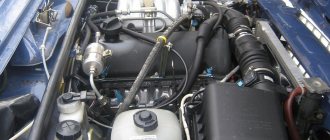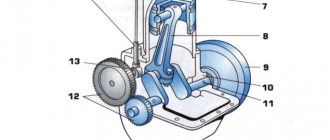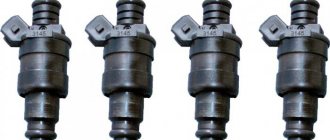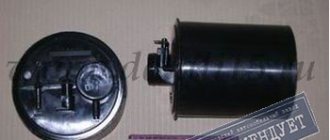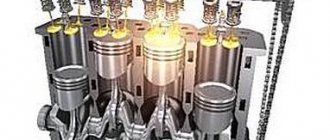Purpose, design and principle of operation of the internal combustion engine pre-heater
An engine preheater is designed to preheat the engine, to facilitate engine starting in cold weather and, in some cases, to warm up the air inside the vehicle.
Modern electric heaters are a whole system consisting of several parts:
an electric heating element with a power of 500-5000 W, located in a sealed heat exchanger, which is mounted in the technological holes of the cooling jacket or connected to it using pipes.
-electronic control unit with timer
-battery charging unit
-fan heater for heating the car interior.
-there are models with a built-in pump for uniform and quick engine warming up
Electric pre-heaters are connected to a 220 V AC power supply. The operating principle of the heater is based on heating the coolant using an electric heating element. Coolant circulation occurs due to the fact that the heated liquid rises to the top of the cooling jacket, and the cooler liquid falls down. Heaters of this operating principle require installation at the lowest point of the cooling system. With a built-in pump, you can install the heater anywhere, and more efficient heating occurs. When a certain temperature is reached, a thermal relay is activated, turning off the heater and preventing the coolant from overheating. This allows you to leave the electric heater on all night.
Autonomous liquid heaters
Diesel engine preheater
Liquid engine pre-heaters are completely autonomous. They are installed in the engine compartment of the car and can run on gasoline, diesel fuel or gas.
Main components of a liquid preheater:
electronic heater control unit (controller that monitors temperature, overheating, fuel supply, air supply, etc.)
fuel pump with fuel line
an air blower that supplies air to the combustion chamber
“boiler”, including a combustion chamber, heat exchanger
circulation pump pumping coolant
relay that turns on the fan of the standard “stove” for heating the interior
heater control unit (timer, remote control, GSM module for starting the heater by phone)
After the heater is started by the control, the heater fuel pump supplies fuel from the vehicle's fuel tank to the heater combustion chamber. In the combustion chamber, fuel is mixed with air and ignited by a spark plug. As a result of fuel combustion, heat is generated, which is transferred through the walls of the vehicle's coolant heat exchanger. The heater pump pumps coolant through the small circuit of the cooling system - the cylinder block jacket and the standard interior heater. When the set coolant temperature is reached, the relay (if equipped) turns on the fan of the standard “stove” to heat the interior. Liquid heaters cannot be used in garages that do not have a ventilation system. Fuel consumption is about 0.5 liters per hour at full load
The advantages of liquid heaters usually include the ability to sit in a warm car interior in the cold with defrosted windows and immediately start driving without wasting time on warming up. In addition, the engine resource increases, since a cold start of the engine further reduces its service life. The disadvantages include the high price of liquid heaters.
The disadvantages include the fact that during operation, the autonomous engine heater, circulation pump, and car interior fan consume electric current from the car's battery. If your car's battery is already weak, this can cause it to drain quickly.
You can also use autonomous heaters when the car is moving to help the standard heating system in particularly cold times, when the car can simply get cold while driving; this can be especially useful for cars with a diesel engine, whose calorific value is lower. Many automakers are already producing cars with a pre-installed autonomous engine heater.
The principle of operation of thermal accumulators is based on the accumulation of a certain volume of heated coolant in a special thermos, where it maintains its temperature for up to two days. When the engine starts, the contents of the thermos are discharged into the small circuit of the cooling system by a special pump, heating up the bulk of the coolant by 15-20 degrees. Such heat accumulators are installed, for example, on the American modification of the Toyota Prius hybrid car.
Diesel fuel heaters
Diesel fuel heaters are designed to dissolve paraffins formed in fuel at low temperatures. They run on a battery; after starting the engine, they can also run on a generator. They are usually divided into bandage-type heaters mounted on a fine fuel filter and fuel line heaters. In turn, fuel line heaters are divided into flow-through heaters, which cut into the fuel system and heat the fuel passing through the heater jacket, and belt heaters, which wrap around problem areas of the fuel line.
Design and principle of operation of autonomous pre-heaters
There are also noname Chinese analogues on the market, which we do not recommend buying, and after studying the design you will understand why. Any autonomous heater, we repeat, aims to generate heat by burning oxygen and fuel in certain proportions. To do this, the design must include:
- The combustion chamber in which fuel is mixed with air and combustion occurs.
- A fuel pump that forces fuel from the tank into the combustion chamber.
- An air blower (fan) that forces air into the combustion chamber.
- Heat exchanger. Hot gases from the combustion chamber enter it and heat either air or liquid.
- Fan or circulation pump. The coolant must circulate throughout the system, which is why a fan is provided in air-powered units or a circulation pump for antifreeze in liquid models.
The combustion process must be kept under control, for which the device is equipped with sensors:
- A temperature sensor or flame indicator that promptly turns off the glow plug, which ignites the fuel at first.
- Air temperature or coolant temperature sensor.
- An overheating sensor that stops the operation of the preheater in emergency situations, somehow the exhaust gas outlet is muffled, etc.
The principle of operation is probably familiar to many from the autonomous stove that was equipped with cars with air-cooled internal combustion engines, for example, ZAZ. The unit, as you know, is capricious and is not particularly reliable, which cannot be said about modern autonomous pre-heaters.
Thus, the “ON” command sent to the electronic unit of the product forces it to diagnose the system. After all, based on the volume of information presented, it is not difficult to assume the level of fire hazard that Webasta carries, and what will happen if one of the systems does not work as expected. So, all power circuits of the device are working, what next? And then this:
- The glow plug and combustion chamber purge fan are turned on.
- After 30 seconds, the system sends the first pulses to the fuel metering pump.
- The fuel-air mixture is ignited and as it burns, the combustion chamber temperature sensor turns off the spark plug. If it does not detect heat within 30-40 seconds, the operation of the unit stops and the start cycle begins again. In the event of a second unsuccessful start, the device goes into purge mode and turns off completely.
- As the coolant warms up, the system can step-by-step reduce combustion power or temporarily suspend operation.
Completion of a successful working cycle is carried out according to the reverse scenario. The fuel pump is turned off first, and the purge fan continues to operate until the flame sensor detects that the heat exchanger and combustion chamber have cooled down.
Engine preheater for diesel
Diesel fuel tends to thicken at subzero temperatures. Such fuel is not only unsuitable for use, but can damage the car. This is in addition to problems with starting, and if the temperature drops to -25°C, you basically have to abandon the idea of going somewhere in your car.
A pre-start engine heater for a diesel engine, whose task is to preheat before starting, radically solves the problem. If you have a high-quality device and an outlet (and it runs on a 220V network), the car will always be ready for the “road” even in the coldest winters.
Why do you need a pre-heater?
The device passes coolant from the car engine through itself and heats it. In this way, the entire engine circuit is heated, which allows it to prepare for starting. Cold starts at sub-zero temperatures are excluded. As this happens, the interior heats up, and we arrive at our car, all the windows are clean, there is no ice or snow, the interior is warm. You can immediately go about your business.
The pre-launch unit itself is connected to the fuel tank. We launch this one, it consumes very little fuel. Essentially this is a combustion chamber that passes coolant through it. It is heated in this device and passes through the circuit of the power unit.
There is still fuel consumption. Such a device can be started either from a special timer, which is installed in the car, or from a remote control. This allows you to get additional comfort and plan your time. You can plan it so that you can enter a weekly schedule into the program when you need to travel by car.
Purpose of preheaters
It is believed that each “cold” start of the engine reduces its service life by 300-500 kilometers. The power unit is under heavy load. Viscous oil does not reach the friction pairs and is far from optimal performance. In addition, a lot of fuel is consumed to warm the engine to an acceptable temperature.
Engine preheater
And in general, it is difficult to find a driver who likes to be in a cold car waiting for the engine to reach the desired temperature. Ideally, everyone wants to get into a car with a warm engine and a warm interior and drive right away. This opportunity is provided by installing an engine preheater.
Types of pre-heaters
The variety of such systems can be divided into two categories:
- autonomous;
- dependent (electrical).
Autonomous heaters
The category of autonomous heaters includes:
- liquid;
- air;
- thermal accumulators.
The air heater acts as an additional heater to heat the interior. It does not warm up the engine or warms up, but only slightly. Such devices have a combustion chamber into which the air-fuel mixture is supplied using a fuel pump and air intake from the outside. Already heated air is supplied to the car interior. The device is powered by a 12V/24V battery, depending on the size of the car and the required power. It is installed mainly in the car interior.
Liquid heaters help warm up not only the interior, but primarily the engine. They are installed in the engine compartment of the car. The heater is connected to the engine cooling system. To warm up, antifreeze is used, which passes through the heater. The generated heat heats the antifreeze through the heat exchanger. A fluid pump helps circulate fluids throughout the system. Warm air is supplied to the cabin using a fan, the electric motor of which is powered from the car's electrical network. Heaters use their own combustion chamber and control unit, which controls the fuel supply, combustion process and temperature.
Hydronic liquid heater device
The fuel consumption of a liquid heater will depend on the operating mode. When the liquid warms up to 70°C - 80°C, the economy mode is activated. After the temperature drops, the heater starts up again on its own. Most liquid devices work on this principle.
Thermal accumulators are not so common, but they are also self-contained heating devices. They are designed on the principle of a thermos. They are an additional tank that contains heated coolant. There is a vacuum layer around the liquid channels that prevents it from cooling quickly. During movement, the liquid circulates fully. During parking, it remains in the device. Antifreeze stays warm for up to 48 hours. The pump supplies fluid to the engine and warms up quickly.
The main requirement for such devices is regular travel. In severe frosts, the liquid will cool faster. It is advisable to use the car every day. The device also takes up quite a lot of space.
Electric heaters
The operating principle of electric analogues can be compared with conventional boilers. A device with a heating element is connected to the engine cylinder block. The device is powered from a 220V household power supply. The spiral heats up and gradually warms up the antifreeze. Coolant circulation occurs due to convection.
Location of the electric heater on the engine
Warming up with electrical devices takes longer and is not as effective. But such devices benefit from accessibility and ease of installation. Dependence on the outlet becomes their main disadvantage. An electric heater can heat the liquid to boiling point, so a timer is supplied with the device. With its help you can set the required warm-up time.
Main manufacturers and models of autonomous heaters
The leading positions in the market of liquid and air heaters have long been occupied by two German companies: Webasto and Eberspacher. Among domestic manufacturers one can name the company Teplostar.
Webasto heaters
They are reliable and economical. Their products are somewhat inferior in cost to their competitors. Webasto's line of heaters includes many models that differ in power. For cars, trucks, buses, special equipment and yachts.
Webasto heater
Thermo Top Evo Comfort+ model from Webasto is suitable for cars with an engine capacity of up to 4 liters. This is the most popular option. There are varieties for gasoline and diesel engines. Power 5 kW. Power supply – 12V. Fuel consumption for 20 minutes of warming up is 0.17 liters. There is an option to warm up the interior.
Eberspächer heaters
This company also produces high-quality and economical heaters for all types of transport. Liquid heaters are branded Hydronic.
Heater Hydronic
The Eberspacher HYDRONIC 3 B4E is ideal for passenger cars with a volume of up to 2 liters. Power – 4 kW, power supply – 12V. Fuel consumption – 0.57 l/hour. Consumption depends on the operating mode.
There are more powerful models for small cars, such as the HYDRONIC B5W S. Power – 5 kW.
Heaters Teplostar
The Teplostar company is a domestic manufacturer of heating devices similar to Webasto and Eberspächer. Their products differ significantly in price from their competitors for the better, but are somewhat inferior in quality. Liquid heaters are produced under the BINAR brand.
BINAR-5S-COMFORT
A popular model is BINAR-5S-COMFORT for small cars with a volume of up to 4 liters. There are petrol and diesel options. Power – 5 kW. Power supply – 12V. Gasoline consumption – 0.7 l/hour.
The Teplostar Diesel engine-heater 14TS-10-12-S is a powerful heater with a 24V power supply and a power of 12 kW - 20 kW. Works on both diesel and gas. Suitable for buses, trucks and special equipment.
The best models of autonomous heaters
| Place in the ranking | Model | Manufacturer country | Price |
| 1 | Webasto Thermo TOP EVO 5 | Germany | 48000-50000 |
| 2 | Webasto Thermo TOP E / Thermo TOP C | Germany | 29000-35000 |
| 3 | Eberspacher Hydronic B4 WS | Germany | 38000-39000 |
| 4 | Binar-5S-COMFORT | Russia | 24000-30000 |
| 5 | Teplostar 14TS-Mini | Russia | 25000-28000 |
Webasto Thermo TOP EVO 5
Heater kit with pump Webasto Thermo TOP EVO 5
Main features of Webasto Thermo TOP EVO 5:
- the main advantage is increased heating power against the background of reduced fuel consumption;
- country of origin - Germany;
- price - 48-50 thousand rubles.
Specifications
| Characteristic | Meaning |
| Operating power | 22/32 kW (partial and full load) |
| Heating capacity | 2.6/5.2 kW (partial and full load) |
| Weight | 2.4 kg |
| Wire length | Not specified |
| Presence of anti-corrosion housing | Yes |
| Fuel used | Gasoline/diesel |
| Coolant | Antifreeze, pressure up to 2.5 atm |
| Startup mode | Manual/automatic |
| Type and frequency of current | Variable, 50 Hertz |
| Auto shutdown (switching temperature) | User configurable |
| Warm-up time | 15-25 minutes |
| Guarantee period | 2 years |
Advantages and disadvantages
| Pros according to reviews | Cons according to reviews |
| Small dimensions | Does not work at temperatures below -40 degrees |
| Versatility - it is possible to install this device on both a passenger car and a truck | Inability to control the remote control if the timer was initially turned on |
| Minimum warm-up time | Defective products often go on sale |
| Increased demands on the battery and the danger of completely draining the battery during short trips |
Reviews
Reviews about this device:
- Mikhail, 29 years old. An expensive device, but it provides guaranteed engine starting in almost any weather. Autonomy allows you to connect the device to a battery, and the system works not only on gasoline and diesel engines, but also on gas engines. The main advantages include a long service life, as well as safe operation for the motor. However, Webasto also has disadvantages, for example, operational reliability and consumer characteristics are highly dependent on the qualifications of the installer. If there are none in your village, it’s better not to install them, otherwise you’ll throw money away.
- Igor, 44 years old. The main advantage of Webasto Thermo Top 5 Evo is its reliability, it warms up the engine normally even at very low temperatures, down to -30 degrees. A serious disadvantage is that once the system is started using a mini-timer, it cannot be turned off from the remote control, what nonsense? I recommend installing it on cars with a powerful battery or buying a more capacitive battery, since the negative charge goes away faster. A friend of mine's same model burned out due to a short circuit (the service center said it was a leak and water got into the control unit). How can a device at such a price be leaky?
Video: installation of the Webasto heating system
User Timur Safin made a video in which he talked about the features of self-installation and use of heating devices with a Webasto Thermo TOP EVO 5 pump.
Webasto Thermo TOP E / Thermo TOP C
Autonomous engine heater with pump Webasto Thermo TOP E
Main features of Webasto Thermo TOP E heating systems:
- the main advantage is that due to the unique design of the device, the load on the battery during its operation is minimal;
- country of origin - Germany;
- The estimated cost is from 29 to 35 thousand rubles.
Specifications
| Characteristic | Meaning |
| Operating power | 22/32 kW on models E and C respectively |
| Heating capacity | 4/5 kW on models E and C respectively |
| Weight | 3.2 kg |
| Wire length | 7.5 m |
| Presence of anti-corrosion housing | Yes |
| Fuel used | Gasoline/Diesel |
| Coolant | Not specified |
| Startup mode | Manual/automatic |
| Type and frequency of current | Variable, 50 Hz |
| Auto shutdown (switching temperature) | 72 degrees |
| Warm-up time | 1 year |
| Guarantee period | 60 minutes |
Advantages and disadvantages
| Benefits according to reviews | Disadvantages according to reviews |
| Quick engine warm-up, especially at critically low temperatures | High cost of installation, repair and maintenance |
| Saving vehicle fuel during startup and warm-up | Low quality of assembly and components, which affects the service life of the device as a whole |
| Small overall dimensions allowing you to expand possible mounting locations in the engine compartment | Increased battery requirements - on short trips the user may run out of battery power |
| The manufacturer has not thought out how to work together with the anti-theft system | |
| Frequent malfunctions of the remote control |
Video: repair of a non-separable Webasto burner
A video has been published on the KPOWERtuning channel, which shows the process of repairing and restoring a non-separable Webasto Thermo TOP E burner by replacing the evaporation mesh.
Eberspacher Hydronic B4 WS
Autonomous heater Eberspacher Hydronic B4 WS
Main features of heaters with pump Eberspacher Hydronic B4 WS:
- the main advantage is the ability to program and remotely start;
- country of origin - Germany;
- Estimated cost: 38-39 thousand rubles.
Specifications
| Characteristic | Meaning |
| Operating power | 10/39 W (minimum and full load) |
| Heating capacity | 1.5-4.3 kW |
| Weight | 2.9 kg |
| Wire length | 2.2 m |
| Presence of anti-corrosion housing | Yes |
| Fuel used | Petrol |
| Coolant | Antifreeze, up to 2.5 atm |
| Startup mode | Manual |
| Type and frequency of current | Variable, 50 Hz |
| Auto shutdown (switching temperature) | 80 degrees |
| Warm-up time | 60 minutes |
| Guarantee period | 2 years |
Advantages and disadvantages
| Benefits according to reviews | Disadvantages according to reviews |
| Ability to start a car engine at critically low temperatures | High cost of purchase and installation |
| The device practically does not drain the battery, especially if the battery is in good condition | |
| High build quality and long service life |
Reviews
Feedback on the operation of Eberspacher Hydronic B4 WS systems:
- Gregory, 52 years old. I installed this thing on a work car and didn’t spend any money on the purchase since these are commercial resources. Fuel consumption after installation was about 0.6 liters per hour. To warm up the engine in 20-degree frost, it takes about 20-25 minutes, that is, about 0.2 liters of fuel. I would like to immediately note that on Lexus IS250 it is better to install Eberspacher Hydronic B4 WS on the right side member, this is recommended by the manufacturer, I personally consulted with the dealer on this issue. I use Jiesem Bilink with two-way communication as a control unit, the configuration is carried out by sending SMS messages, and confirmations are sent in response to the phone. The main disadvantage is the price; I would not install such a heater on a personal car; I would find something cheaper.
- Vasily, 30 years old. The main advantages are autonomy and comfort. Before this, I used OWL heaters in winter, but their main condition for operation is connection to a 220-volt network. In this case, the device must be connected to a standard battery, but if it is very weak or discharges quickly during a cold start, it is better to immediately change it to a more capacitive one. It has been working without failures for three years now, but the price is the main disadvantage.
Video: self-configuration of Eberspacher Hydronic B4 WS systems
User Alexey Ivanovich in his video spoke in detail about self-configuring the control unit for an autonomous heater.
Binar-5S-COMFORT
Autonomous heater with pump Binar-5S-COMFORT
Main features of Binar-5S-COMFORT devices:
- the main advantage is the expanded capabilities of operation in both preheater and reheater modes;
- country of origin - Russia;
- The estimated cost is from 24 to 30 thousand rubles.
Specifications
| Characteristic | Meaning |
| Operating power | 42 W |
| Heating capacity | 5 kW |
| Weight | 8 kg |
| Wire length | Not specified |
| Presence of anti-corrosion housing | Yes |
| Fuel used | Petrol |
| Coolant | Antifreeze, pressure up to 2.5 atm |
| Startup mode | Manual, automatic (remote timer) |
| Type and frequency of current | Variable, 50 Hz |
| Auto shutdown (switching temperature) | User configurable |
| Warm-up time | 20-120 min depending on air temperature |
| Guarantee period | 18 months |
Advantages and disadvantages
| Pros according to reviews | Cons according to reviews |
| Compact compared to other models in this line | Defective products often go on sale |
| Choice of installation options | Possible failure of the electronic component, thermostat or control unit |
| Ability to control the device remotely | Poor build quality |
| Availability of engine heater option | |
| Possibility of control via call, via SMS messages or using an application for a mobile device | |
| Availability of a self-diagnosis system | |
| Possibility of additional connection of a GSM module |
Video: first launch of the Binar-5S-COMFORT system after installation
User Max Leontev in his video showed how to properly start an autonomous Binar heater after installation and what should be taken into account when doing so.
Teplostar 14TS-Mini
Heating device with pump Teplostar 14TS-Mini
Main features of pre-start autonomous heaters Teplostar 14TS-Mini:
- the main advantage is the ability to set the time (select the heater operating time from 40 minutes to 2 hours) and automatically shut down the work;
- country of origin - Russia;
- The estimated cost is from 25 to 28 thousand rubles.
Specifications
| Characteristic | Meaning |
| Operating power | 74-110 W (for passenger cars) or 76-130 W (for trucks) |
| Heating capacity | 4-14 kW (for passenger cars) or 9.5-14.2 kW (for trucks) |
| Weight | 16 kg |
| Wire length | Not specified |
| Presence of anti-corrosion housing | Not specified |
| Fuel used | Diesel fuel |
| Coolant | Antifreeze, Antifreeze |
| Startup mode | Manual, automatic |
| Type and frequency of current | Variable, 50 Hz |
| Auto shutdown (switching temperature) | User configurable |
| Warm-up time | 20-60 minutes |
| Guarantee period | 12 months |
Advantages and disadvantages
| Benefits according to reviews | Disadvantages according to reviews |
| Extending the service life of the power unit | In practice, devices do not always allow starting the engine at temperatures less than -20 degrees |
| Possibility of additional heating of the interior of a car with the engine turned off | |
| Saving fuel on a car with a warm engine |
Reviews
Review of the Teplostar 14TS-Mini device:
Alexey, 47 years old. I installed this thing on the Tiguan because the stock Webasto burned out and could not be restored. I installed it and regretted it, since Russian quality still makes itself felt; it would have been better to add and buy Webasto or Eberspacher. It starts exactly at temperatures down to -20 degrees, if it’s -21 and below, it won’t start. In rare cases, if the battery is fully charged, it may start in extreme cold. In general - money down the drain.
Video: installing a heating system on an ISUZU car
User Vasily Shirokov in his video showed in detail the process of self-installation of an autonomous Teplostar heater.
Major manufacturers of electric heaters
Among the manufacturers of dependent electric heaters are DEFA, Severs and Nomakon.
DEFA heaters
These are compact models that are powered by 220V.
Model DEFA 411027 is small in size and easy to use. During operation, the oil heats up. To warm up at temperatures below -10°C, you need an average of half an hour of heater operation.
Electric heater DEFA
You can also highlight the cabin and engine heater Defa Warm Up WarmUp 1350 Futura . Powered by mains and battery.
Heaters from Severs company
The company produces preheaters. A popular brand is Severs-M . This is a compact device that is easy to install. Power – 1.5 kW. Powered by household power supply. It warms up to 95°C, then the thermostat operates and turns off the device. When the temperature drops to 60°C, the device automatically turns on.
Severs 103.3741 model has similar characteristics as Severs-M. Differs in operating mode. It takes an average of 1-1.5 hours to warm up the engine. The device is protected from moisture and short circuit.
Nomacon heaters
Model Nomakon PP-201 is a small compact device. Installed on the fuel filter. Can operate from a standard battery or from a household network.
Fuel heaters
Although diesel fuel heaters are used for the same purpose as all other devices in this category, they work on a different principle. Their main purpose is to prevent the formation of paraffins as a result of cooling the fuel mixture, due to which even a warm engine will not be able to start. Such equipment can be successfully installed on all types of structures, and thanks to its simple design, you can easily install it yourself, having a sufficient level of knowledge in auto mechanics. These devices provide:
- efficient fuel heating;
- accelerated start of the propulsion system even at air temperatures down to -40C;
- the ability to refuse expensive additives;
- reduced energy consumption.
The device carries out heating in a marching or pre-launch method. The first increases the permeability of the filters, and the second is designed for the free movement of the mixture through the system.
Which preheater is better?
All the devices presented above have their advantages and disadvantages. Autonomous liquid heaters such as Webasto or Eberspächer are very good, but they are quite expensive. The average cost starts from 35,000 rubles and above. Of course, if the driver has the opportunity to install such devices, then he will receive maximum comfort. The devices are controlled from the interior via a smartphone and remote key fob. Customizable as desired.
Electric heaters are significantly more expensive. Their cost starts from 5,000 rubles. Some models perform quite well in practice, but they depend on the outlet. You must have access to electricity. This is their minus.
Operating principle of the engine preheater
The engine preheater is installed on various types of equipment, from civilian passenger cars to heavy trucks, special vehicles, etc. Equipping the engine and interior with a pre-heating device makes it easier to start the internal combustion engine, increase the life of the power plant and significantly improve operating comfort in winter.
Next, we will look at what types of engine pre-heaters there are, and we will study the principle of operation of pre-heating. We will also try to answer the question of what advantages and disadvantages this or that type of engine and car interior heaters from the general group of similar devices has.
Pre-heater - what is it?
Autonomous devices and heaters operating from a 220 V network - the market offers us two types of engine preheating systems.
The result of the devices' operation is the same: they heat the coolant, and the warm coolant warms the engine and interior through the standard heating system. Autonomous ones do this on their own, converting fuel and air into heat, and 220 V class products heat like boilers, taking energy through a household outlet. However, autonomous heaters are not only liquid, but also air. The purpose of the latter is to heat only the interior of large dimensions, say, a truck or a minibus. In passenger cars, such heaters are inferior in price to homemade fan heaters and other solutions.
What is an engine preheater and its design?
Let's start with the fact that there are several types of internal combustion engine heaters, which differ in their principle of operation, purpose, performance, dimensions and a number of other parameters and characteristics. As a rule, heaters are often divided into:
- liquid autonomous;
- electrical;
Now let's look at these solutions in more detail. So, the most common option is an autonomous liquid engine preheater. Many drivers are well aware of such devices from the brands Webasto, Hydronic, Teplostar, etc.
Moreover, both types of heaters are autonomous. The devices take fuel (gasoline, diesel fuel) from the main tank or a separate tank (included with the autonomous heater). Next, this fuel is burned in a small combustion chamber.
These solutions are economical, since fuel consumption is low, a minimum of electricity is also consumed, and the heaters have a reduced noise level during operation. It is also worth noting its versatility, since the heater can be installed on a gasoline, diesel, gas or gas-diesel engine, an engine with gas equipment, etc.
As a rule, autonomous preheaters are installed in the engine compartment, after which they are also connected to the engine cooling system. The air heater does not require such a connection. The device is installed in the cabin, since its task is not to heat the coolant, but to supply heated air into the air ducts.
How does an autonomous engine preheater work?
Let's start with the fact that the liquid heater is a ready-made installation kit. The main elements are:
- boiler with combustion chamber;
- liquid radiator;
- fuel supply lines;
- fuel pump;
- liquid pump;
- thermal relay;
- electronic heater unit;
- controls;
So, after the device receives a start signal, electric current begins to flow to the executive motor. This engine drives a special fuel pump, which is included in the heater design. At the same time, the fan starts working. The pump pumps fuel, after which the fuel evaporates in the evaporator. Air also enters the heater.
As a result, a fuel-air mixture is formed, which enters the combustion chamber and is ignited by a spark on the spark plug. The thermal energy that is generated after combustion is transferred to the coolant in the cooling system through a special heat exchanger.
The coolant itself circulates. Circulation is made possible thanks to the operation of the booster pump, which is included in the design of the heater. Thus, the liquid heated and circulating through the cooling jacket is able to transfer heat to a cold engine.
If we talk about air heaters, in this device the burner heats only the air and does not heat the coolant. In automatic mode, the device is “oriented” according to the air temperature in the cabin or cabin. In other words, the heater maintains a particular air temperature set by the user, and also works for as long as the driver has programmed.
Both liquid and air heaters are equipped with various controls, which allows you to control the device not only from inside the vehicle, but also remotely. Among the main functions, we should highlight the ability to automatically turn on the preheater using a timer, and start the heater remotely from a key fob or using a mobile phone.
Autonomous pre-heaters
This type of engine pre-heater is the most functional, since it does not depend on connection to external energy sources (that’s why they are called autonomous). However, their cost is higher than electric ones. It is quite difficult to install such engine heating yourself without having the necessary technical skills and sufficient experience. In addition, independent installation of such high-tech devices leads to loss of warranty on the car.
On a note! If you install the heater in an authorized center, then all warranty obligations are retained.
And, despite the rather high cost, such devices are widely popular. By analogy with autonomous heating systems for buildings, such devices are sometimes called boilers. Until recently, the most famous manufacturers of these products were the German Webasto and Eberspacher (Hydronic). But now Russian and Teplostar are worthy competition; as well as the Chinese "Belief".
Autonomous heating consists of:
- fuel pump;
- glow plug or glow pin (tungsten or cobalt);
- evaporation burner;
- combustion chambers;
- heat exchanger;
- supercharger motor;
- coolant inlet and outlet pipes;
- control unit.
The boiler is installed in the engine compartment and built into the fuel and cooling systems of the car. The diagram below helps you understand how an autonomous heater works.
When the device is turned on (by a button, a signal from a timer, a remote control unit or a GSM module), the air-fuel mixture enters the combustion chamber and is ignited by the glow plug (or glow pin). When the mixture burns, the heat exchanger heats up, which leads to heating of the coolant. The pump pumps antifreeze through the engine and radiator of the standard interior heating system. When the liquid temperature reaches about 60°C, the automation unit turns on the interior fan.
The “Webasto Thermo Top Evo Start” heater (power 5 kW), designed for installation on cars with an engine capacity of up to 5 liters, with a programmable weekly timer and installation parts costs about 25,000 rubles. The remote control unit (range of about 1 km) and the GSM unit (for the ability to control from a mobile phone) must be purchased separately. Installation by a certified dealer will cost no more than 8,000÷10,000 rubles.
Operating principle of electric engine heating
The electric heater is a spiral that is screwed into the engine cylinder block. An electric coil is installed instead of a plug in the block. The principle of operation is quite simple. A current passes through the spiral, the spiral heats up, which allows the antifreeze or antifreeze to be heated as a result. Coolant circulation and heat distribution occurs naturally (due to convection).
The fact is that the electric heating of the engine is not autonomous. The device is powered from an external outlet, which in many cases becomes a significant drawback. Another disadvantage is that such a solution consumes quite a lot of electric current.
To ensure that the coolant is heated to a certain temperature and further maintains such a temperature, the owner himself sets the temperature range. To put it simply, it comes with a timer that allows you to set the desired temperature. After the coolant is heated to the required value, the spiral is turned off.
Then, when the liquid temperature drops to a certain threshold, the device will turn on again in automatic mode. We also note that the electric heater allows you to warm up not only the engine, but also the interior. After heating the coolant, the standard stove fan turns on, after which warm air comes out of the air ducts. It is also possible to recharge the battery in parallel with the pre-heating of the power unit.
Electric heaters
Such devices are a spiral mounted in a cylinder block. It replaces the plug installed in the block. They work quite simply - when an electric current is passed through it, heating occurs, the resulting thermal energy is supplied to the coolant, which speeds up the process of its circulation. This heating takes longer, and most models operate exclusively when connected to the power grid. But the device itself is much cheaper. After reaching the required temperature, according to the temperature range set by the user, the device goes into standby mode. Once the sensors detect that the device is cooling, they turn it on again to achieve the desired result.
Heating the engine using a heat accumulator
This type of engine heaters is less common compared to other analogues. Similar solutions on the market are represented by Gulfstream, Autoterm, etc. systems.
The principle of operation of these heat accumulators is that after the coolant is warmed up as a result of engine operation, antifreeze or antifreeze accumulates in a special container, where it remains hot for up to 48 hours. The next time you start a cold engine, warm liquid enters the cooling system, which allows you to quickly warm up the engine and interior.
Thermal accumulators
Thermal accumulators are classified as a liquid type of car heater. The essence of the work is that the tubes of the car’s cooling system pass through such a battery. During engine operation, excess heat accumulates in the battery and remains there for up to 48 hours. When starting a cooled engine, the pump turns on and when pumping antifreeze or antifreeze, heat is transferred to the cooling system.
The main advantage of such a device is high heating efficiency and long-term heat retention. Disadvantages include the complexity of installation and the need to replace components of the device. Over time, valves, tubes and control levers wear out. Another disadvantage of operation is its cost. On average, a heat accumulator will cost a car enthusiast 7–8 thousand rubles.
When purchasing a heat accumulator, you should not purchase models made in China or Russia. It is best to pay attention to devices created in Scandinavian countries. Such heaters can boast of high quality, good heat retention and operating efficiency.
Engine preheater: advantages
As you know, engine wear is most intense at the moment it is started. At the same time, low temperatures affect the viscosity of the engine oil (the lubricant thickens), the lubricating and protective properties deteriorate.
As a result, after a cold start, friction increases; in the first seconds, loaded parts experience oil starvation. Often the parts that wear out the fastest are the crankshaft, cylinder-piston and timing gear. At the same time, the ability to avoid cold starts and quickly warm up the internal combustion engine to operating temperatures allows us to say that the engine is operated in a gentle mode.

